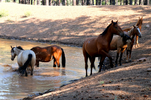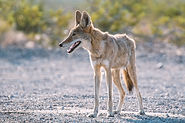Rocky Mountain Elk
Cervus canadensis nelsoni

Look for herds at dawn/dusk in open meadows.
The Rocky Mountain elk is a large and powerful deer species found in Arizona’s mountain meadows, forests, and high-elevation grasslands. Adult bulls are recognized by their impressive branching antlers, which are shed and regrown annually, and by their deep, resonant bugling calls during the fall rut that can carry for miles across valleys and meadows. Elk are primarily grazers and browsers, feeding on grasses, shrubs, and tree bark depending on the season. They are most active at dawn and dusk, often moving in herds that provide protection against predators. As a keystone species, Rocky Mountain elk play a significant role in shaping vegetation and supporting predator populations, while offering wildlife enthusiasts one of the most iconic and memorable sightings in Arizona’s high country.
Mammal

Identification & Behavior
Key Features: Large body, tan coat, dark neck mane
Size: Cows 500 lbs, bulls 700–1,000 lbs
Behavior: Form herds, bulls defend harems in rut.
Diet: Herbivore — grasses, shrubs, bark
Activity Pattern: Crepuscular
Habitat & Distribution
Found in northern and eastern Arizona, including the Kaibab Plateau, Mogollon Rim, and White Mountains. Inhabits ponderosa pine forests, meadows, and riparian corridors along streams and rivers. Present in Kaibab, Coconino, Apache-Sitgreaves, and White Mountain forests, often near high-elevation plateaus.
Elevation Range: 5,000–10,000 ft
Seasonal Presence: Year-round
Risks & Management
Use caution around bulls during rut.









































